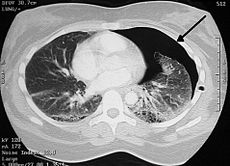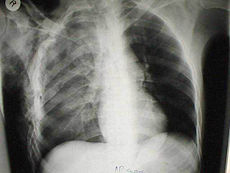- Chest trauma
-
Chest trauma Classification and external resources 
A CT scan of a pneumothoraxeMedicine med/2916 med/3658 MeSH D013898 Chest trauma (or thoracic trauma) is a serious injury of the chest. Thoracic trauma is a common cause of significant disability and mortality, the leading cause of death from physical trauma after head and spinal cord injury.[1] Blunt thoracic injuries are the primary or a contributing cause of about a quarter of all trauma-related deaths.[1] The mortality rate is about 10%.[2] Chest injuries were first described in detail in around 1600 BC in the ancient Egyptian Edwin Smith Papyrus.[3]
Contents
Classification
 A chest X-ray of a right sided pulmonary contusion associated with flail chest and subcutaneous emphysema
A chest X-ray of a right sided pulmonary contusion associated with flail chest and subcutaneous emphysema
Chest trauma can be classified as blunt or penetrating. Blunt and penetrating injuries have different pathophysiologies and clinical courses.
Specific types of chest trauma include:
- Injuries to the chest wall
- Chest wall contusions or hematomas.
- Rib fractures
- Flail chest
- Sternal fractures
- Fractures of the shoulder girdle
- Pulmonary injury (injury to the lung) and injuries involving the pleural space
- Injury to the airways
- Tracheobronchial tear
- Cardiac injury
- Pericardial tamponade
- Myocardial contusion
- Blood vessel injuries
- Traumatic aortic rupture, thoracic aorta injury, aortic dissection
- And injuries to other structures within the torso
- Esophageal injury (Boerhaave syndrome)
- Diaphragm injury
Diagnosis
Most blunt injuries are managed with relatively simple interventions like tracheal intubation and mechanical ventilation and chest tube insertion. Diagnosis of blunt injuries may be more difficult and require additional investigations such as CT scanning. Penetrating injuries often require surgery, and complex investigations are usually not needed to come to a diagnosis. Patients with penetrating trauma may deteriorate rapidly, but may also recover much faster than patients with blunt injury.
References
- ^ a b Keough V, Pudelek B (2001). "Blunt chest trauma: Review of selected pulmonary injuries focusing on pulmonary contusion". AACN Clinical Issues 12 (2): 270–281. doi:10.1097/00044067-200105000-00010. PMID 11759554. http://meta.wkhealth.com/pt/pt-core/template-journal/lwwgateway/media/landingpage.htm?issn=1079-0713&volume=12&issue=2&spage=270.
- ^ Moloney JT, Fowler SJ, Chang W (February 2008). "Anesthetic management of thoracic trauma". Current Opinion in Anaesthesiology 21 (1): 41–46. doi:10.1097/ACO.0b013e3282f2aadc. PMID 18195608.
- ^ Miller DL, Mansour KA (2007). "Blunt traumatic lung injuries". Thoracic Surgery Clinics 17 (1): 57–61. doi:10.1016/j.thorsurg.2007.03.017. PMID 17650697.
External links
Nonmusculoskeletal injuries of head (head injury) and neck (S00–S19, 850–854) Intracranial see neurotraumaExtracranial/
facial traumaEither/both M: EYE
anat(g/a/p)/phys/devp/prot
noco/cong/tumr, epon
proc, drug(S1A/1E/1F/1L)
M: EAR
anat(e/p)/phys/devp
noco/cong, epon
proc, drug(S2)
Chest trauma, excluding fractures (S20–S29, 860–862) Cardiac and
circulatory system injuriesvascular: Traumatic aortic rupture (Thoracic aorta injury)heart: Myocardial contusion/Commotio cordis · Cardiac tamponade · Hemopericardium · Myocardial ruptureLung and
lower respiratory tract injuriesGeneral wounds and injuries (T08-T35, 870-949) General Wound/
traumaBlister (Blood blister • Coma blister • Delayed blister • Edema blister • Fracture blister • Friction blister • Sucking blister)
Bruise/Hematoma/Ecchymosis (Battle's sign, Raccoon eyes, Black eye, Subungual hematoma, Cullen's sign, Grey Turner's sign, Retroperitoneal hemorrhage)
Animal bite: Insect bite · Spider biteAnimal bite: Snakebite · Lizard bite
Ballistic traumaForeign body In alimentary tract (Bezoar)Other By region Categories:- Medical emergencies
- Chest trauma
- Injuries to the chest wall
Wikimedia Foundation. 2010.
